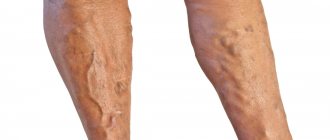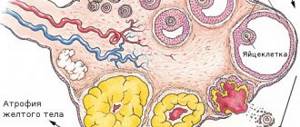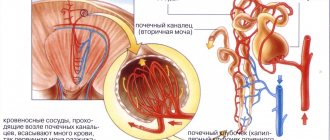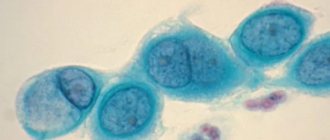Atrophic gastritis is a form of chronic inflammation of the inner lining of the stomach. It is caused by a special type of pathogenic bacteria - Helicobacter pylori. A long-term inflammatory process changes the cellular structure of the gastric mucosa, leading to a decrease in the production of hydrochloric acid, and then to more pronounced atrophic disorders. As a result, this disease can become a harbinger of stomach cancer.
- Symptoms of the disease
- Diagnosis of atrophic gastritis
- Treatment
Diet and daily routine
- Drug therapy
- Traditional methods
- Video about diagnostic and treatment methods
Atrophic gastritis: symptoms and treatment in women
Atrophic gastritis in women is a long-term disease of the stomach, characterized by the fact that against the background of a moderately pronounced inflammatory process, atrophy of the glandular apparatus occurs and the regeneration processes of the mucous membrane are disrupted.
The symptoms and treatment of the pathology are the same as in men; they depend on the etiology of the disease, the severity and localization of the atrophic process. Manifestations of the disease are quite scarce: abdominal discomfort, belching, occasional nausea, hypersalivation, unstable stool. Treatment includes antibiotics, drugs that normalize the pH of gastric juice, prokinetics, enzymes, and vitamins.
Statistics
The prevalence of chronic atrophic gastritis (AG) in men in the adult population is significantly higher than in women (66% in men and 49% in women).
Gender differences in gastroenterological pathology have just begun to be studied, so many questions are not yet clear. However, it has been shown that in three groups of women the incidence is the same as in men of the same age and even higher:
- Atrophic gastritis in women of menopausal age . This is associated with a decrease in progesterone levels, a slowdown in metabolism, and changes in the functioning of the nervous system. As a result, the trophism of internal organs, including the stomach, suffers.
- Atrophic gastritis during pregnancy , which is associated with a decrease in the body's protective functions and activation of Helicobacter pylori infection; in addition, pregnant women suffer from autoimmune forms of atrophic gastritis more often than in the general population.
- The autoimmune form of atrophic gastritis is diagnosed in women three times more often than in men, the reason for this is not clear.
Hypertension is a fairly severe pathology that can lead to metaplasia, dysplasia and malignancy. Knowing this, women immediately ask two questions: “How long do they live with this disease and how to treat it?”
Chronic atrophic gastritis in itself does not lead to death, and the processes of atrophy and metaplasia can be slowed down, transferring the condition into a phase of stable remission, while you can live for a long time. Treatment of the disease is quite developed; it is the same for men and women.
Disease prevention
The onset of remission does not mean that the disease will not return.
Chronic atrophic gastritis of the stomach in this condition will continue to exist until pathogenic microorganisms, non-compliance with doctor's instructions or other factors aggravate it.
You can maintain your stomach health by following a number of recommendations:
Intoxic is an anthelmintic that safely removes parasites from the body. Intoxic is better than antibiotics because: 1. It kills parasites in a short time and gently removes them from the body. 2. Does not cause side effects, restores organs and reliably protects the body. 3. Has a number of medical recommendations as a safe remedy. 4. Has a completely natural composition.
- Adhere to a healthy lifestyle. Regular walks, physical activity, proper nutrition - all this will help improve not only the condition of the stomach, but also the body as a whole.
- Maintain hand hygiene. This will help avoid not only exacerbation of chronic gastritis, but also various forms of poisoning.
- Following the recommendations of the attending physician. After successful treatment of chronic atrophic gastritis in the acute stage, bismuth preparations, physiotherapy and herbal medicine, and mineral water are prescribed.
- It is necessary to monitor the condition of the intestines. There should be stool at least once a day.
Patients over 65 years of age should pay special attention to their condition: in old age, degenerative processes occur much faster. Only a doctor can determine how to treat the disease.
We cannot ignore the signals our body gives. It is imperative to listen to him and monitor all changes in well-being.
If abdominal pain does not go away for a long time and gets worse, then this is a clear reason to consult a specialist.
Do not self-medicate under any circumstances, be it using “magic” pills from an advertisement or the good advice of a relative. Such treatment can lead to irreversible consequences.
A competent approach to treatment and prevention of further development of the disease will help to shorten the treatment period as much as possible and reduce the harm caused to the body.
We should not forget about regular examinations, which will help identify pathology at an early stage and successfully cope with it.
Atrophic gastritis in women: symptoms
The disease can be focal or diffuse in nature. Symptoms of atrophic gastritis in women depend on the etiology of the atrophic process and its localization.
In the hyperplastic type of gastritis (occurring with hyperplasia of the mucous glands, intestinal metaplasia and atrophy of acid-producing glands), signs of a hypoacid state with almost zero acidity are observed:
- abdominal discomfort;
- nausea;
- hypersalivation,
- stool instability
- flatulence.
With autoimmune gastritis, the clinic is determined by anemia and achlorhydria (lack of free acid in gastric juice, as a result of atrophy of the lining cells of the stomach).
Gastric mucosa (atrophic gastritis) on FGDS
Anemia with atrophic gastritis is characterized by symptoms:
- weakness and fatigue;
- dry and brittle nails;
- pain and burning in the tongue;
- shortness of breath, palpitations.
Symptoms of achlorhydria are nonspecific - heaviness and feeling of fullness in the abdomen, nausea, belching, epigastric pain.
AG with low acidity
The characteristic symptoms of atrophic gastritis with low acidity, with an infectious genesis of the disease, occur when the number of parietal cells becomes minimal.
- decreased appetite;
- discomfort and bloating in the stomach;
- hypersalivation;
- burping;
- bitterness in the mouth;
- rumbling in the stomach;
- flatulence;
- unstable stool (constipation alternates with diarrhea).
AH with high acidity
Symptoms of atrophic gastritis with high acidity are clearly expressed at the beginning of the atrophic process, as a compensatory reaction. The hyperacid contents of the stomach, acting on the mucous membrane, causes the formation of acute erosions and even ulcers, often complicated by hemorrhages.
In this case, the woman complains about:
- moderate abdominal pain;
- heartburn;
- nausea, belching;
- a persistent feeling of bitterness in the mouth.
If bleeding occurs, vomiting mixed with blood and melena may occur.
Do you need a diet?
Of course, therapeutic nutrition is not able to independently remove H. pylori from the body and completely eliminate duodeno-gastric reflux.
However, no drug can fully demonstrate its effect when consuming “aggressive” food products.
With increased stress on the stomach, there is often a need to take additional medications or increase their dose. And the irritating influence of spicy or fried foods significantly slows down the restoration of the mucous membrane.
Information. The main danger of antral gastritis is the increased risk of developing a cancer process in conditions of long-term inflammation (10 years or more).
According to a European study by Sipponen et al., conducted on 370 patients, when the antrum is affected, the risk of developing gastric cancer increases by almost 9-32%.
Women are more exposed to this danger.
As with other forms of gastritis, in the acute period of inflammation of the antrum, the most gentle table No. 1a is recommended. After a couple of days, they usually switch to a higher-calorie diet No. 1b.
Since antral gastritis, as a rule, is associated with increased acidity of gastric juice, after stabilization of the condition, table No. 1 is prescribed.
If inflammation persists for many years and the mucous membrane atrophies, then the secretion of hydrochloric acid may decrease. In this case, diet No. 2 is recommended.
Why does atrophic gastritis occur?
There are two main causes of atrophic gastritis in women:
- autoimmune processes;
- H. pylori infection
One of the causes of atrophic gastritis in women is Helicobacter pylori.
With autoimmune gastritis, the disease develops very quickly. A pathological autoimmune cascade, the causes of which are not clear, quickly leads to atrophy of the gastric mucosa. In this case, a clinical picture of atrophic gastritis develops with symptoms of anemia.
But before the cascade begins to act, the antibody titer must reach a certain value. Affect the rate of antibody accumulation at the initial stage:
- genetic predisposition;
- hypovitaminosis;
- bad habits;
- somatic diseases;
- starvation;
- chronic infections.
There is no etiotropic treatment for this condition.
When infected with H. pylori, the bacteria are first localized in the antrum, then in the body of the stomach, after which they populate all parts of the organ, causing several stages of the disease: first inflammation, hyperacid reaction, and then atrophy of the gastric mucosa with intestinal metaplasia.
During endoscopy, in the initial stage, hyperemia and swelling of the mucous membrane are determined without signs of a violation of its integrity (superficial gastritis). In the hyperacid stage, against the background of hyperemic mucosa, FGDS (usually in the antrum) reveals erosive and ulcerative defects of varying severity, often with a hemorrhagic component. When the process passes into the atrophic stage, at the very beginning a mixed type of gastritis is determined, when areas with signs of mucosal atrophy alternate with areas without signs of atrophy. Gradually, the area of the atrophied mucosa expands, and pangastritis occurs (damage to the entire surface of the stomach).
Types of disease
It is important to diagnose the disease on time. Symptoms of this type are sometimes confused with signs of other gastrointestinal dysfunctions.
Types of this gastric pathology:
- Subatrophic. Characterized by damage to the upper layer, affecting exclusively the mucous membrane.
- Antral. It develops at the junction of the duodenum and the stomach itself. But the pathology, if left untreated, spreads to other parts of the main digestive organ. Unpleasant signs include scars, ulcers, and impaired acid production.
- Focal. It affects specific areas of the mucosa, leads to a decrease in the amount of pepsin, as a result of which glands cease to exist in the inflamed areas, and metaplasia is possible. In their place, a simple epithelial layer of tissue is formed.
Focal gastritis occurs in certain areas of the gastric mucosa
- Multifactorial view. He is considered one of the most dangerous. The pathology spreads to all layers, walls, glands atrophy, cells sometimes change structure and mutate. Advanced forms sometimes lead to cancer. Polyps and cysts may develop - then a hyperplastic type of pathology is diagnosed.
However, a diet plan can prolong the state of remission. Its variations were developed by therapist Pevzner for each type of disease. Effective nutritional plans will help with stomach inflammation. They cannot be neglected: the patient’s well-being and improvement in the condition of the stomach depend on this.
Dietary nutrition will help prevent exacerbations of the disease
Diagnostics and research methods
If a woman experiences symptoms suspicious of atrophic gastritis, she should immediately contact a gastroenterologist, who, after examination, will prescribe a comprehensive examination:
- Endoscopic examination: confirms the existence of atrophic gastritis, determines the condition of the mucous membrane. In case of hypertension, a biopsy is required to determine the degree of metaplasia and dysplasia.
- Long-term pH measurement determines the concentration of H+ ions in the gastric cavity, which is necessary for choosing the correct drug treatment.
- The Biohit hematological panel, quite widely introduced into practice, is a modern laboratory examination method, it allows you to determine the degree of atrophy and metaplasia of the mucosa (during the examination, the level of serum pepsinogen, the ratio of pepsinogen 1 to pepsinogen 2, as well as the level of histamine 1 are determined).
- Capillary blood is examined for signs of anemia.
- A stool test for blood is done if bleeding is suspected.
- A breath test for Helicobacter pylori infection is required.
Atrophic gastritis: treatment in women
Treatment of atrophic gastritis includes: diet therapy, drug treatment, physiotherapy, traditional medicine.
Drug treatment
Drug therapy is aimed at the complete destruction of Helicobacter pylori infection, restoration of gastrointestinal tract function, and restoration of the gastric mucosa.
Table 1. Drugs for the treatment of atrophic gastritis in women
| What is the treatment aimed at? | Drugs |
| Atrophic gastritis in women with high acidity | |
| Antibacterial drugs (any treatment regimen for Helicobacter pylori eradication includes at least two drugs with antibacterial action) | Amoxicillin, Clarithromycin, Arvicin, Kriksan, Panclave |
| Probiotics (to normalize intestinal microflora) | Lactobacterin, Biobakton |
| Prebiotics | Duphalac |
| Drugs that normalize the pH of gastric juice | PPI (Omez, Pariet, Nolpaza); antacids (Almagel A, Phosphalugel) |
| Gastroprotectors | De-nol, Vikalin, Venter, Rebagit, Befungin |
| Prokinetics | Trimedat, Domperidone, Cerucal |
| Drugs that improve regeneration | Trimedat, Domperidone, Cerucal |
| Antispasmodics (for severe pain) | Papaverine, No-shpa |
| Atrophic gastritis in women with low acidity | |
| Replacement therapy that the patient will have to take for the rest of his life | Abomin, Pepsidil, Acidin-pepsin |
| Enzyme therapy (enzymes) | Creon, Pangrol |
| Drugs that restore mucous membranes | Solcoseryl, Riboxin, Aloe vera, Actovegin |
| Vitamin therapy | Vitamin B₁₂ |
| Stimulation of gastric secretory function | Plantaglucide |
Medical nutrition
The diet for atrophic gastritis in women should mainly be based on the recommendations of table No. 2 according to Pevzner. Otherwise, drug treatment will not be effective, and symptoms of exacerbation of the disease may occur.
- dried wheat or yesterday's bread;
- dietary meat (young rabbit, veal), poultry (turkey fillet, chicken);
- low-fat varieties of fish (pollock fillet, pike);
- eggs (quail, chicken) soft-boiled or in the form of omelettes;
- cottage cheese, cheese, fermented baked milk;
- porridge cooked in water or vegetable broth (buckwheat, rice, oatmeal);
- soups (without meat broth), vegetables in soups must be thoroughly ground;
- vegetables, during an exacerbation period after heat treatment (steamed, boiled, stewed);
- allowed ripe fruits and non-acidic berries (sweet apples, blueberries, watermelon in season, bananas);
- natural bee honey;
- dried, but not fried seeds;
- diluted juices, tea, decoctions of dried fruits, jelly.
- poorly digestible foods (fatty and stringy meat, fatty varieties of sea fish, rye bread, smoked meats, sauces, peas, beans, margarine);
- fresh, soft bread, rich pastries;
- Undesirable cereals: pearl barley, corn; – they have coarse fibers, their digestion is difficult);
- irritating mucous membranes (onions, garlic, chocolate, turmeric);
- undiluted juices, strong tea, coffee, milk.
Traditional medicine
Table 2. Folk remedies for the treatment of atrophic gastritis in women
| Facilities | Method of use |
| Propolis tincture with alcohol | 20 drops of alcohol tincture are diluted in 50 ml of warm milk. Drink 3 times a day |
| Sea buckthorn oil | 2 teaspoons of oil are diluted in 200 ml of warm milk, drunk in the morning before meals. There is information that the product restores the mucous membrane even with hyperplastic gastritis |
| Oatmeal jelly | Pour oatmeal (1 cup) with 2 cups of cold water. Leave for 12 hours, strain and boil until thick. You can add honey or butter. Serve as a separate dish |
| Bee mummy | 1 gram of the substance is dissolved in a liter of milk. Drink 1 glass 30 minutes before meals, three times a day |
| Kelp | Thaw the kelp and boil it. Use as an independent dish, seasoned with olive oil, or added to other dishes. |
Treatment of the chronic form of the disease
In the chronic stage of the disease, it is recommended to use traditional medicine such as:
- sea buckthorn oil. This remedy allows you to cope even with the advanced stage of the disease, but subject to increased acidity. It is recommended to take the oil in the morning before meals, two teaspoons diluted in milk. The oil copes well with heartburn attacks;
- chamomile decoction. If there is low acidity, it is recommended to add honey to the broth.
Such simple but effective methods will normalize acidity, easing the general well-being of the patient. Before starting treatment, be sure to consult with your doctor.
Anemia with atrophic gastritis in women
Anemia with atrophic gastritis can be the result of two reasons:
- iron deficiency in the body;
- lack of vitamin B₁₂.
Iron deficiency anemia develops as a result of insufficient absorption of iron in atrophic gastritis. The result is a violation of hemoglobinopoiesis (hemoglobin synthesis).
Symptoms of anemia in women with atrophic gastritis:
- weakness;
- decreased performance;
- noise in ears;
- fainting conditions;
- tachycardia;
- shortness of breath on exertion.
Treatment includes diet, iron supplementation, and red blood cell transfusion.
Pernicious anemia is the result of a lack of vitamin B₁₂ in the body. Pathology develops with autoimmune gastritis. The pathogenesis of the disease is complex and not fully understood. The formation of autoantibodies to parietal cells causes their death. Vitamin B₁₂ does not enter the body (the absorption mechanism is impaired). As a result, there is a deficiency of coenzyme forms of vitamin B₁₂ necessary for erythropoiesis. The process of growth and maturation of red blood cells is disrupted. Red blood cells take the form of megaloblasts (large cells) that are unable to transport oxygen.
Pernicious anemia syndromes in women:
- hypoxic (tachycardia, shortness of breath);
- gastroenterological (glossitis, hepatomegaly, gastroenterocolitis);
- neurological (ataxia, sensitivity disorder, polyneuritis).
Treatment includes the prescription of glucocorticoids, in addition, the patient must take vitamin B₁₂ in the form of a drug throughout his life.
Drug therapy
How to treat atrophic gastritis of the stomach? For the treatment of atrophic gastritis, several groups of drugs are used, which are selected on the basis of diagnostic studies, taking into account the stage and form of the disease, as well as the individual characteristics of the patient:
- Antibiotic therapy. The goal is to destroy foreign bacterial flora that provokes the destruction of the mucous membrane. For this purpose, antibiotics of the penicillin group, Clarithromycin, Metronidazole are used. Treatment is carried out until the bacteria of the genus Helicobacter are completely eliminated from the sample.
- Proton pump inhibitor, Omeprozole, Omez, Lansoprozole. Drugs that block the production of hydrochloric acid in the stomach in atrophic gastritis are used in combination with antibiotics. The course of treatment coincides with the duration of taking antibiotics.
- Gastroprotectors. These include, De-Nol, Solcoseryl. Their action is aimed at protecting and healing damaged gastric mucosa and improving blood microcirculation in the walls of the organ.
- Tonic medications, Befungin, Almagel. They improve metabolic processes in glandular epithelial cells, regulate their metabolism, and relieve pain after eating.
- Vitamin and enzyme preparations, Maalox, Mezim-forte. They increase the body’s resistance to adverse factors and normalize the digestion process.
The attending physician may introduce medications into the course of treatment to eliminate disturbing symptoms.
Lifestyle of a woman with atrophic gastritis
If a woman has atrophic gastritis, first of all, it is necessary to exclude factors contributing to the progression of the disease:
- It is necessary to adjust the diet. You need to eat regularly at the same time, take food in small portions, increasing the number of meals to 5-6 times a day.
- Dietary recommendations must be followed.
- Quit tobacco and alcohol completely.
- Perform all necessary diagnostic tests and take medications in a timely manner.
- Avoid overwork, both physical and mental.
- At the first sign of exacerbation, consult a doctor.
Atrophic gastritis of the stomach
The inner surface of the stomach is lined with tissue, which is characterized by constant cell renewal. Any disruption of the surface layer of the mucous membrane activates cell reproduction and accelerates their movement to the site of damage. The original cellular composition is restored.
Atrophic gastritis is a long-term, recurrent chronic inflammation of the gastric mucosa. During illness, the physiological renewal of cells on the mucosal surface is disrupted, and a restructuring of its constituent parts occurs. Due to the long course of structural disorders, the gastric glands lose the ability to fully function. The process of producing secretions (pepsin, acid), gastric motility, and digestive processes in the intestines are disrupted. Intestinal metaplasia of the mucous environment is formed - replacement of the gastric glands with intestinal epithelial tissue.
Atrophic gastritis is the leading background precursor to gastric cancer. A high risk of cancer formation is noted in those who suffer from pathology from youth.
Basic treatment methods
Conservative treatment of atrophic gastritis includes:
- drug treatment,
- diet therapy,
- using the best methods of traditional medicine,
- special measures to restore the gastric mucosa,
- giving up bad habits, following a diet,
- sanatorium-resort treatment in health resorts of the appropriate profile.
Do not think that all patients with atrophic gastritis are doomed to stomach cancer. The body has serious defense mechanisms that prevent the growth of cancer cells. In addition, adequate treatment of gastritis of the stomach and compliance with doctor’s instructions remove the threat of further cell degeneration.
Reasons for the development of atrophic gastritis
Atrophic type gastritis is formed by internal and external factors. The leading causes of the development of the disease are as follows:
- disorders of the mucous surface of an autoimmune nature – 10% of pathologies, type of gastritis – A;
- infection of the gastric mucosa with the bacterium Helicobacter pylori – 85% of cases, type of gastritis – B;
- duodenogastric reflux - reflux of the contents of the duodenum into the stomach cavity and the damaging effects of bile acids, lysolecithin on the mucous surface - 5% of cases, type of gastritis - C.
Helicobacter pylori (Helicobacter pylori) is an unusual bacterium. It survives in the acidic environment of the stomach and actively progresses in it. The microorganism produces urease, a medium that reduces the aggressiveness of hydrochloric acid produced by gastric juice. A neutral environment is formed around each bacterial cell, preserving the infectious agent. Colonization of microorganisms on the mucous membrane damages the epithelial tissue and develops inflammation in the submucosal layer. Internal superficial gastritis recurs and becomes a chronic process.
A good acid background for the active activity of Helicobacter pylori is a value from 3.0 to 6.0. Therefore, the pathogen resides in the antrum (lower) part of the stomach, which passes into the duodenum. If acidity increases, the pathogen moves to the duodenum. If the acidity decreases, the bacterium migrates to the body and fundus of the stomach.
Atrophy of the mucosal surface is also developed by autoimmune disorders: the immune system produces antibodies to the parietal cells of the glands that produce gastric secretions. This destroys the cells of the mucous surface, and atrophic gastritis of the autoimmune type is formed.
The formation of duodenogastric reflux is associated with incomplete closure of the sphincter at the pyloric opening, chronic inflammation of the duodenum, and increased pressure in it. Reflux gastritis leads to damage to the inner surface of the stomach by bile acids, their salts, pancreatic enzymes, lysolecithin and other components of the contents of the small intestine.
Reflux gastritis is also called “chemical-toxic gastritis.” The pathology develops with the constant use of certain medications (mainly non-steroidal anti-inflammatory drugs) and chemicals. There are other circumstances that provoke the formation of atrophic gastritis:
- mental disorders;
- violations of the principles of healthy eating - irregular rhythm, oversaturation, swallowing large pieces, increased consumption of hot, spicy foods, coffee, monotonous diet;
- smoking, alcohol abuse;
- long-term treatment with medications that have a harmful effect on the inner lining of the stomach - acetylsalicylic acid and its derivatives, the glucocorticosteroid prednisolone, digitalis-based drugs and others;
- chemical agents;
- radiation;
- infectious diseases of a chronic nature - tuberculosis, cholecystitis, infections of the oral cavity, nasopharynx and others;
- chronic obstructive bronchitis, pulmonary emphysema, bronchial asthma;
- diseases associated with disruption of the endocrine glands - bronze disease, decreased thyroid function, Itsenko-Cushing's disease, Graves' disease, diabetes mellitus;
- metabolic disorders - excess weight, gout, anemia;
- diseases leading to oxygen starvation of the gastric mucosa - pulmonary failure, heart failure;
- cirrhosis of the liver;
- self-poisoning – retention of toxic products due to kidney failure – uremia;
- heredity.
The occurrence and development of atrophic gastritis is associated with the multiple influence of various unfavorable circumstances.
Diagnosis of the disease
The diagnosis of “atrophic gastritis” is made based on the results of the examination:
- symptoms of illness;
- study of secretion production;
- X-ray examination of the organ;
- information obtained during examination with an endoscope;
- checking for the presence of Helicobacter pylori infection;
- histological analysis of biological tissue.
The main method for establishing a diagnosis is EGDS (esophagogastroduodenoscopy). Examination with a probe makes it possible to see the condition of the mucous surface, take biological tissue to detect Helicobacter pylori, and confirm the diagnosis. With atrophic gastritis, the mucous membrane becomes thinner, has a pale grayish color, the size of the folds decreases, and with the strong development of the atrophic process, the folds almost disappear completely.
Diagnostics
Diagnosis of atrophic gastritis is based on an analysis of the clinical manifestations of the disease, endoscopic examination data, histological examination of gastric biopsies, assessment of the functional activity of the stomach and diagnosis of Helicobacter pylori infection.
Functional diagnosis of atrophic gastritis includes:
- pH measurement, which can be used to determine the secretory ability of parietal cells;
- study of the activity of gastric enzymes and the general proteolytic activity of gastric juice; diagnostics of the motor function of the digestive tract based on the results of gastrography.
Daily pH-metry is the “gold standard” for assessing the secretory function of the stomach in atrophic gastritis. Its implementation is necessary to determine the patient’s treatment tactics, prognosis and monitor the effectiveness of therapy. On average, daily pH ranges from 3 to 6.
A mandatory study for any form of gastritis is to determine the presence of the Helicobacter pylori bacterium on the mucous membrane. This study allows us to determine the cause of damage to the mucous membrane of the organ, since in most cases the predisposing factor in the development of atrophic gastritis is a long-term Helicobacter infection.
Symptoms and treatment in women
Atrophic gastritis is manifested by local and systemic disorders of the body. Local disorders are manifested by signs of indigestion (dyspepsia):
- a feeling of heaviness, pressure, fullness in the stomach area (under the chest), which arises and increases during meals and some time later;
- nausea, belching;
- unpleasant taste in the mouth;
- burning in the stomach;
- burning in the esophageal tube, confirming the reflux of stomach contents into the tube, disruption of the passage of the food bolus.
These symptoms appear in some forms of gastritis of the antrum of the stomach, developing disorders of food movement, increased pressure inside the stomach, increased reflux of its contents into the lumen of the esophageal tube and a corresponding exacerbation of the mentioned clinical signs of pathology.
Atrophic gastritis of the middle part of the stomach is notified by a feeling of heaviness under the chest, under the ribs, which appears when eating, and soon after it. In patients with infectious Helicobacter-associated gastritis, which lasts for a long time with an increase in the production of gastric secretions, clinical symptoms of intestinal dysfunction are possible. This is a violation of the emptying process: lack of stool, diarrhea, unstable rhythm of bowel movements, flatulence, rumbling. Allergic gastritis occurs with the following symptoms:
- constant diarrhea;
- intolerance to certain foods, medications;
- pain in the abdominal area;
- feeling of nausea, vomiting;
- weight loss;
- increased number of eosinophils (eosinophilia).
Systemic disorders occur with the following symptom complexes:
- Asthenic (neurotic) syndrome - general weakness, unstable mental state, disorders of the cardiovascular system (a feeling of compression in the heart, irregular heart rate, instability of blood pressure with a predominance of its decrease).
- Gastritis in the stage of insufficient secretion production forms a complex of symptoms similar to dumping syndrome (accelerated movement of stomach contents into the intestines without proper digestion): severe weakness, disturbance of the rhythm of bowel movements, sweating occurring after eating, hiccups, pallor, drowsiness, quick feeling of fullness.
- Gastritis of the middle part of the stomach with the simultaneous formation of B12-deficiency anemia is characterized by a constant feeling of fatigue and lethargy. The patient loses interest in life, his vitality decreases. It hurts and burns in the mouth, on the tongue, there are sensitivity disorders that occur simultaneously in the arms and legs and are expressed in burning, tingling, and a crawling sensation.
- Antral infectious (Helicobacter) gastritis, which occurs with excessive secretion production, is manifested by a complex of symptoms similar to peptic ulcer disease, since the patient develops this pathology: vomiting, pain characteristic of an ulcer.
There are also signs such as weight loss, symptoms of vitamin deficiency - seizures, excessive thickening of the stratum corneum of the epidermis, brittle hair and nails.
Therapy of atrophic gastritis
An exacerbation of the disease requires adherence to a diet with restrictions that apply only during this period. After the onset of remission, it is necessary to eat nutritiously. Patients with suppressed, low secretion production of the gastric glands adhere to a regimen of their stimulation in the diet. For any gastritis, the following foods are prohibited:
- alcoholic drinks, coffee, carbonated drinks;
- canning, spices, smoked foods;
- fried, fatty, spiced food;
- surrogates, concentrates of any products;
- chocolate;
- fast food - fast food;
- baked goods;
- products that stimulate fermentation - black bread, dairy products, grapes.
You need to eat a little, but often - 5 - 6 times a day. The diet is balanced, varied, and not limited exclusively to cereals and broths. It is important to have enough protein in your diet.
Treatment of atrophic gastritis type A (autoimmune)
At the initial stage of the disease, as it progresses, if the stomach produces secretions, but the immune processes are deeply disturbed, the patient is prescribed glucocorticosteroid hormonal drugs. If painful symptoms do not bother you (in remission), there is no need for treatment.
If the production of glandular secretions decreases, the patient is prescribed diet No. 2 according to Pevzner (see Table 1), a combination of natural gastric juice preparations with drugs that improve the motor activity of the lower part of the stomach, accelerating its emptying - Motilium, Motilak. Table 1
| Description of the diet table | Diet | Calorie table | Dietary products | Cooking | Meal schedule |
| A complete diet high in extracts. Avoid foods that are difficult for the stomach to digest and remain in it for a long time. The diet stimulates the production of secretions and inhibits the progression of the disease. | 90 – 100 g of proteins, 90 – 100 g of fats, 400 – 450 g of carbohydrates, 1.5 liters of liquid, no more than 10 – 12 g of table salt. The daily norm is 3 kg of food. | 3000 kcal | Egg dishes, porridges, casseroles, vegetable purees, meat gravies, soups with vegetables, meat and fish, stale white bread, mousses, compotes. | Grinding products of varying degrees, frying without breading, boiling, baking dishes. | The temperature of ready-made hot dishes is about 60˚С, cold – below 15˚С, eat small portions, frequently (4 – 5 times a day). |
When anemia associated with vitamin B12 deficiency develops, this vitamin is prescribed for treatment. With reduced production of pancreatic juice, patients take Creon, Pancreatin, Panzinorm.
Treatment of atrophic gastritis type B (Helicobacter) with high acidity
Treatment of type B gastritis is aimed at eliminating the causative agent of the infection. Clinical recommendations from World Health Organization specialists call first-line anti-Helicobacter drugs metronidazole (tinidazole), clarithromycin, amoxicillin, tetracycline, de-nol. The types of main antisecretory drugs are listed in Table 2. Table 2
| Group of drugs | Drug names |
| Anticholinergics | atropine sulfate, gastrocepin |
| H2 blockers |
|
| Proton pump inhibitors |
|
| Combination drug | Pylorid |
A month and a half after completion of the course of therapy, a follow-up examination is carried out. If the treatment did not completely eliminate the infection, the sensitivity of Helicobacter pylori to antimicrobial drugs is determined to prescribe a second course.











